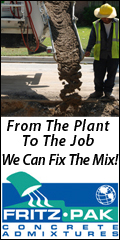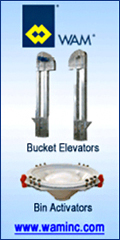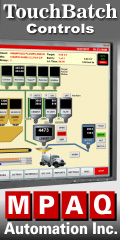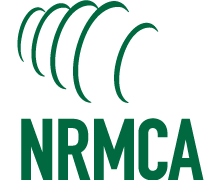
| Archive | nrmca.org | E-Store | Conferences & Events | Certifications | InFocus |
NRMCA Reports on ACI Fall Convention The American Concrete Institute's (ACI) 2012 Fall Convention was held last month in Toronto. Below is an update of some of activities that involved NRMCA interests.
130 – Sustainability Committee - Lionel Lemay is NRMCA’s representative on ACI 130 Committee on Sustainability. The committee continues to march slowly toward an in-depth document on the sustainability of concrete. Lemay has written the chapters on materials, concrete proportioning and production and will have all negatives resolved by mid-April 2013. The chapters reference several NRMCA programs to meet sustainability objectives, including Green-Star, Sustainable Concrete Plant Certification and Environmental Product Declarations. Lemay is also working on chapters related to sustainability design tools, rating systems and codes and standards, and has been selected to be on the final editing team. NRMCA’s Karthik Obla has written sections on recycled wash water and recycled returned concrete. The document is expected to be finalized in 2013.
132 – Responsibilities in Concrete Construction - The committee addressed several comments as it works toward completing a comprehensive document that discusses the individual and joint responsibilities of stakeholders in concrete construction. The document is moving through the ACI approval process. The committee will offer a seminar session and panel discussion on the topic of Responsibilities at the next convention in Minneapolis. NRMCA's Colin Lobo is on this committee.
201 – Durability - NRMCA’s Karthik Obla maintains representation on ACI 201. The 201.2R Guide to Durable Concrete is being revised. A new chapter on physical salt attack due to sulfates is complete. Physical salt attack resembles surface scaling due to freezing and thawing and is different from chemical sulfate attack.
211 – Mixture Proportioning - Karthik Obla maintains representation on ACI 211. The document Standard Practice for Selecting Proportions for Normal, Heavyweight, and Mass Concrete is being re-balloted. Comments from the Technical Activities Committee (TAC) on the new chapter on concrete mixture submittals have been addressed by the committee. This chapter includes examples of prescriptive and performance submittals. TAC suggestions on the new chapter on mixture evaluation concrete mixture submittals have been addressed by the committee. New task groups are working on mixture proportioning for pumping and mixture proportioning; ground limestone powder and mineral fillers will be handled in separate sections.
214 – Strength Tests - This committee is looking for project compressive strength test data to update the table showing the standards of concrete control for both testing variability as well as batch to batch variability. Karthik Obla attended the meeting as an associate member.
232 – Fly Ash and Natural Pozzolans - Karthik Obla is chairman of ACI 232. The committee is involved in responding to the TAC suggestions on ACI 232.2R, Use of Fly Ash in concrete. The committee voted on a new report on high volume fly ash (HVFA) concrete. This report will be revised and reballoted by Spring 2013. A substantially revised ACI 232.1R, Use of Natural Pozzolans in Concrete, has been completed. A new task group has been created on Glass Derived Pozzolans.
Tom Adams with the American Coal Ash Association (ACAA) mentioned that new legislation to direct the EPA to manage coal ash disposal in a manner similar to that used for municipal solid waste has been introduced in the Senate with strong bipartisan sponsorship. However, the bill will most likely have to find a vehicle to carry it in the upcoming legislative session. The House has passed a similar bill on three occasions already. It is expected that if the bill gets to the President's desk he may sign it. The EPA has submitted information to a federal court last week that it cannot get a rule published for at least one year, making the possibility of EPA finalizing a coal ash disposal rule unlikely in 2013. The court is hearing a complaint brought by 11 environmental groups and two ash marketers contending that the agency has failed to comply with regulations requiring review and revision of regulations under the Resource Conservation and Recovery Act every three years. The objective of the complaint is to force the court to set a deadline for EPA regulation.
The ACI Spring 2013 convention will feature two sessions on Green Cements and they will be cosponsored with ACI Committees 236, 363 and 130. In addition, there is likely to be a session on fly ash in honor of Dick Stehly sponsored by Committee 232.
301 – Specifications for Structural Concrete - ACI Committee 301 is working on several revisions to the specification in this cycle. Resolutions of ballots have resulted in revisions to the sections on lightweight concrete, mass concrete, shrinkage compensating concrete, formwork and tilt up concrete. In the sections on concrete materials, Section 4, revisions were approved to remove a default cement type, change aggregate submittal requirements, using water to conform to ASTM C1602 (which permits the use of wash water), requiring air entrained concrete only when exposed to freeze thaw cycles, revising requirements for admixtures and to require plants to be certified by NRMCA or an equivalent program or approved by state highway agencies. The committee is also working on including requirements for alkali silica reactions. There are several outstanding revisions to Section 4 that have to reach committee consensus. ACI 301 is working toward completing its revised specification by Fall 2013. Colin Lobo maintains representation on ACI 301.
318 – Building Code for Structural Concrete - The committee continues its frantic pace of achieving consensus on a reorganized member-based code. To accommodate the review process and meet a deadline for adoption into the International Building Code, the document has to be essentially completed by summer 2013. The chapters on materials have been completed with commentary incorporated. Some code revisions that impact concrete materials include changing some of the defined durability exposure classifications and requirements to concrete and to include reference to ASTM C595 on blended cement that permits up to 15% limestone addition. Other revisions at this time are relatively minor. Major revisions are being deferred to the next code cycle. An important decision made in this meeting is that the 318 Code is written to the Licensed Design Professional and contractors do not have responsibility for code requirements that are not included in contract documents. This decision was necessary as all construction related provisions are being gathered into one chapter. Colin Lobo maintains representation on ACI 318.
325 – Concrete Pavements - NRMCA’s Brian Killingsworth maintains representation on ACI 325 on Concrete Pavements. The committee currently has five documents under development or revision. The report ACI 325.9R Guide for Construction of Concrete Pavements has been completely revised and the committee is currently responding to TAC comments. The committee is also working toward re-approval of ACI 325.12R-02: Guide for Design of Jointed Concrete Pavements for Streets and Local Roads. Killingsworth has revised the document making U.S. Customary Units primary and has corrected the design thickness tables, while also addressing a few editorial issues. A complete revision with updated thickness tables and other technical revisions will begin after the document is reapproved.
The committee is developing ACI 325.XR Report on Precast Concrete Pavements - State of the Practice which is based upon work completed by Tayabji for SHRP2. Eventually, this document will become a design and construction report for precast and prestressed pavements. The committee is also developing ACI 325.YR Proportioning, Quality Control and Evaluation of Concrete Pavement Strength Relationships. The document is complete and is being prepared for balloting by the Spring 2013 convention. A revision is underway of 325.11R Accelerated Techniques for Concrete Paving. Work is in the initial stages but progress has been good. The effort will harmonize with the proportioning document. Killingsworth will ensure that considerations for streets and local roads will be included in the revised document.
327 – Roller-Compacted Concrete Pavements - Brian Killingsworth will maintain representation on this committee. Current activities include resolving negative votes on the report ACI 327.XR Report on Roller-Compacted Concrete Pavements. The committee will also begin development of an RCC specification for materials and construction to supplement report 327.XR.
329 – Performance Criteria for Materials for Ready Mixed Concrete - The committee has completed a review by the Technical Activities Committee (TAC) and is responding to these comments before this document is finalized. It should be available as a Committee 329 report by Spring 2013. The committee will request TAC to develop a guide specification on performance requirements for concrete and with this development will suggest revisions to ACI 301 and 318 for future consideration. Some of NRMCA's developed recommendations to specifications will be used for this purpose. The committee is also developing a standard presentation discussing the benefits of evolving to performance-based specifications for improved quality and to support sustainable construction. Colin Lobo and Karthik Obla maintain representation on Committee 329.
330 – Parking Lots - Amy Miller remains staff liaison to the committee. A task group reviewed and resolved negative comments from TAC for ACI 330.1 xx "Design and Construction of Concrete Site Paving for Industrial and Trucking Facilities." Committee now awaits ACI staff and/or TAC to initiate public response.
332 – Residential - Lionel Lemay is NRMCA’s representative on the ACI 332 Committee on Residential Concrete Work. The committee responded to Technical Activities Committee (TAC) comments ACI 332-13 Code Requirements for Residential Structural Concrete. Most TAC comments were resolved. However, one major comment still needs to be addressed. TAC would like to see durability criteria in residential concrete be handled in the same way as ACI 318, for freezing and thawing, sulfates and chlorides. They would like to see the Exposure Class concept be used in residential work. NRMCA is opposed to this approach since it requires someone with significant technical knowledge of concrete and most building officials and contractors do not have the expertise. ACI 318 requires the design professional select Exposure Class, but most projects under the jurisdiction of ACI 332 would not be design professionals. NRMCA will continue to work with the committee to oppose this dangerous move toward a potential unworkable residential code.
522 – Pervious Concrete - As it finalizes the specification for pervious concrete (ACI 522.1), Committee 522 reviewed several public comments as the last part of the review process. This resulted in some changes to the specification document. The committee is also working on revisions to the guide document, ACI 522R, with a goal of publishing the next version in 2014. The committee is developing standard details for pervious concrete pavements. Amy Miller maintains representation on Committee 522.
555 – Recycled Materials - Karthik Obla maintains representation on ACI 555. The document Removal and Reuse of Hardened Concrete is undergoing revisions and will include discussions on crushed returned concrete aggregates based on research work conducted at the NRMCA Research Laboratory. There will be two sessions on recycled materials in concrete and they are likely to feature presentations by NRMCA engineers on wash water and crushed concrete aggregate.
Session on Natural Pozzolans - Karthik Obla presented Natural Pozzolans – An Overview during a session sponsored by ACI 232.
Other News
1. ACI Cement and Concrete Terminology will soon become a standard.
2. ACI 377 – A new technical committee on Performance Based Structural Integrity and Resilience has been created.
For more information, contact Karthik Obla at kobla@nrmca.org.
|
|
|






